Train surfing
Train surfing (also known as train hopping or train hitching) is the act of riding on the outside of a moving train, tram or another rail transport. In a number of countries, the term train hopping is used synonymously with freight hopping, which means riding on the outside of a freight train, while train surfing can be practiced on any type of train. This type of travelling can be dangerous and even life-threatening, because there is a risk of death or serious injury from falling off a moving train, electrocution from power supply (overhead catenary wire, current collectors, resistors, etc.), colliding with a railway infrastructure (bridges, tunnels, platforms, railway signals or other trains) while riding outside off structure gauge on the side or on the roof of a train, or unsuccessful attempts to jump on a moving train or off it. Today, the practice is forbidden by statutes on many railroads in the world. Despite this, it is still practiced, especially on those railroads where the trains are overcrowded.
History


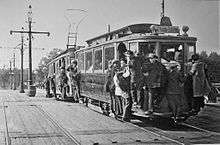
The phenomenon of riding on the outside of trains came with the appearance of the first railway lines. On a series of first railroads, riding on rooftops and footboards of trains was common, but over time, starting from the second half of the 19th century, with an increase in the sizes and speed of trains, passenger coaches began to be produced fully covered and insulated from streets with a placement of all passenger seats inside carriages in order to improve the safety of passengers and prevent people falling from a moving train. However, some individuals continued riding on the outside of trains to travel without having a ticket.
In the United States, this became a common means of transportation following the American Civil War as the railroads began pushing westward, especially among migrant workers who became known as "hobos". It continued to be widely used by those unable to afford other transportation, especially during times of widespread economic dislocation such as the Great Depression.
In the first half of the 20th century during the era of trams rising in Europe and USA, trams in some cities became overcrowded, so some passengers began a practice of riding on footboards, doors, couplers and sometimes on the roofs of trams. Also, train surfing often occurred in European countries during the war conflicts, especially during the First World War, Russian Civil War and World War II. Soldiers and refugees often traveled on the roofs of carriages due to lack of seats inside.
In the mid-20th century, European and American railroad companies in many countries took measures to reduce overcrowding in cars and prevent riding outside of them, so the prevalence of train surfing in those countries decreased. However, in some countries of Southeast Asia and Africa with a high population density, the problem of overcrowding of different vehicles, including trains, grew rapidly, so train surfing in those countries became a widespread phenomenon.
As an extreme hobby, train surfing firstly appeared in South Africa during the 1980s among teenagers from poor families, and then began to appear in other countries around the world. A story from 1988[1] reports how teenagers as young as 13 had taken up surfing atop train cars in Brazil. During the 1990s, train surfing on a commuter electric multiple unit train became popular in Europe among young people who live near railway lines.
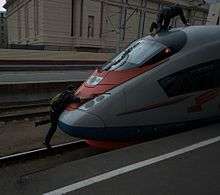
In Germany, the practice of S-Bahn surfing was made popular during the 1990s. The phenomenon was forgotten until the millennium, but in 2005 it was rediscovered by a group of train surfers from Frankfurt, Germany. The leader of the crew who calls himself "the Trainrider" surfed the InterCityExpress, the fastest train in Germany. An Internet video claimed that he died a year later from an incurable form of leukemia, but later the Trainrider revealed in an interview that this video was made by a fan and the story of his death was a hoax.[2][3]
In the Soviet Union during the 1980s, teens and youths sometimes surfed trams. After the dissolution of the Soviet Union, the practice of surfing on electric multiple unit trains appeared during the 1990s in Russia and some other post-Soviet countries due to economic crisis and growing of interest for extreme recreational activities among teens and youths, who live near the railroads. At the beginning of 21st century, they also began to surf subway trains in Moscow Metro and organized train surfing crews and web-communities.[4][5] In the mid-2000s, a problem of frequent cancellation of commuter trains and crowding inside rail cars appeared in the Moscow region. In summer 2010, dozens of commuter trains were cancelled due to track repairs on the Moscow railway, so the crowding of trains and number of train surfers in Moscow region has risen dramatically. It was the first time when a train surfing became a wide phenomenon in modern Russian Railways and it caused a big scandal. Train surfing was mostly a teenager hobby before this. After the railroad reconstruction the situation became stable and the cases of roof riding among the ordinary passengers disappeared.
However, roof riding became more popular among the teenagers, who began to create a community of train surfers and post videos on YouTube. Train surfers began to organize meetings and big-way surfing events on the outside of commuter, subway and local freight trains via the Internet.[6] Russian train surfing fans began to call themselves "Zatseper" and also name their hobby "Zatseping" (from the Russian word "Зацепиться-Zatsepitsya" translated as "to catch on"). Train surfing became something like an extreme sport discipline for them. From the beginning of 2011, Russian train surfers made several rides on the outside of the high-speed Siemens Velaro train "Sapsan", the fastest train in Russia.[7][8][9][10]
In Indonesia, especially Greater Jakarta, large numbers of people train surf,[11] especially since the late 1990s, as gridlock grips this metropolis of 30 million without a single metro system, and the city comes up with alternative transport such as car jockeys. Jakarta traffic is the most gridlocked in Southeast Asia, perhaps among the worst worldwide. It has built bus rapid transit, but with little success, as there is no separation from the heavy traffic. The tropical heat and urban heat island effect also makes the top the only place on the train with plenty of air circulation. Since 2013 the practice has been eliminated after the state railway company modernized the ticketing system, allowing ticket to be sold up to 90 days in advance, and including check in requirements along with increasing number of rolling stocks. On commuter services, stations are modernized by installing turnstile, implementing contactless payment and locking down the station. All non-commuter train now have passenger limit of 100 to 110% while previously a service could run at 200% or more capacity.
Current state
Train surfing is a common and usual way to ride trains in countries such as India, Bangladesh and South Africa, where this type of riding by trains is compelled due to the high population density and severe overcrowding of trains. This practice is a serious issue in these countries where people have been killed or injured in numerous accidents. However, train surfing can occur in any area with trains and trams. Individuals may train-surf to avoid the cost of a ticket or as a recreational activity.
With the creation of the internet, the practice of filming the act and posting online videos of it is on the increase worldwide. Train surfers can use social networks to find and communicate with each other and organize trips by trains in small groups. In countries where a big community of train surfers exists, they sometimes organize major events of riding on the outside of local trains, where dozens of riders participate.
Some railroad workers, such as shunters or conductors, are often allowed to ride on exterior parts of trains during shunting operations, but with many limitations.[12]
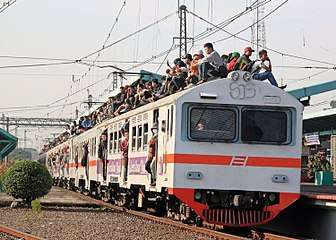 A crowded KRL Jabotabek electric multiple-unit train with passengers riding on the outside in Jakarta, Indonesia
A crowded KRL Jabotabek electric multiple-unit train with passengers riding on the outside in Jakarta, Indonesia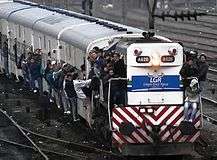 Train Surfing on a diesel locomotive and passenger coaches at Roca Line, Buenos Aires
Train Surfing on a diesel locomotive and passenger coaches at Roca Line, Buenos Aires- Train surfing on a diesel locomotive at Circum-Baikal Railway, Russia
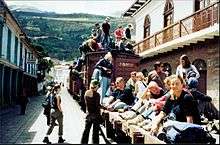 Train surfing on a freight train at Nariz del Diablo, Ecuador
Train surfing on a freight train at Nariz del Diablo, Ecuador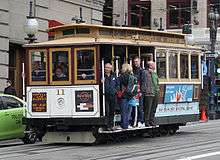 Cable car surfing in San Francisco, the United States. This method of riding is explicitly permitted, subject to certain rules.
Cable car surfing in San Francisco, the United States. This method of riding is explicitly permitted, subject to certain rules. A railroad worker riding on the side of an electric shunting locomotive in Prague, Czech Republic
A railroad worker riding on the side of an electric shunting locomotive in Prague, Czech Republic
Motivation
Passengers who practice train surfing consider it as an extreme hobby, or to get a free ride by train, which has a number of advantages in comparison with riding inside a railcar:[4][5]
- enjoyment of riding and feeling of speed;
- extended view of surrounding area in comparison with the view from a window inside a railcar;
- opportunity to avoid the cost of a ticket;
- opportunity to ride in comfort when a train is extremely crowded;
- opportunity to ride a train which simply has no room for more people, need to go to work;
- opportunity to ride in comfort when there is a strong heat inside railcars;
- opportunity to catch a departing train or jump from an arriving train at low speed before a complete stop;
- opportunity to ride on a train which does not provide transportation of passengers (for example on a freight train, service train, single locomotive, etc.).
Risks
Train surfers are at risk of injury or death from falling, striking wayside objects, or electrocution.[13] Electrocution from overhead lines is a risk whilst on top of a train.[14] As well as health risks, train surfers may also face prosecution by the railway police and guards.
- Hazards for roof riders – overhead power lines, current collectors and electric busbar on the roof of electric train.
 A London Underground deep-level tube train leaving a tunnel. Attempts to ride on the side or on the roof of underground trains are extremely dangerous, because the clearance between the train and the tunnel wall is very small on many underground systems.
A London Underground deep-level tube train leaving a tunnel. Attempts to ride on the side or on the roof of underground trains are extremely dangerous, because the clearance between the train and the tunnel wall is very small on many underground systems.
Injuries and deaths
It was reported that "in 2012, 17 Moscow minors were injured as a result of hooking, 29 in 2013, and 48 children in 2014. In 2015, 25 cases of injuries to minors were recorded (13 of them were fatal)."[15]For 2016 in the central federal district 34 people were injured with 9 of these people dying from their injuries.[16]In 2012 it was reported that dozens of people had been involved in accidents while train surfing in Russia in the past year.[17]
A 1988 report [1] states that some 150 train surfers were killed in Brazil in 1987 and at least 40 in the first half of 1988. According to the article, hundreds more were injured, some permanently paralyzed. The report also states that the government company that runs the commuter lines had paid the equivalent of $700,000 in death and injury claims. In August 2000 there had been "over 100 fatalities in more than 200 registered accidents over the past 10 years" related to train surfing in Brazil.[18]
In Germany between 1989 and 1995 there were 41 train surfing accidents. 18 of these 41 accidents resulted in the person's death and the age range was from 13 to 25.[19]In 2008, forty teenagers died in Germany because of train surfing.[20]
In Ukraine train surfing resulted in 38 people being injured and 16 being killed in 2016 while in 2015 48 people were injured with 18 cases resulting in death.[21] In October 2018 it was reported that "...last year, 12 teenagers were killed hooking, this year already two."[22]
Prevention and punishments

Train surfing is illegal on most railways in the world, with some exceptions. Many railroad companies usually take a zero tolerance policy to practice of riding on exterior parts of trains, and employ railway police and guards in an attempt to prevent the practice. Police officers and guards usually patrol the territory of large passenger stations and freight yards, and can arrest train surfers if they are spotted. In some countries, railway police can patrol the territory of railways in utility trucks, SUVs ("bullmobiles"), or even standard police cars. In countries where the practice of trains surfing occurs regularly, the police frequently organize raids in order to detect and remove surfers off the trains and arrest them.[23] The most common form of penalty for train surfers is a fine, however, in some countries, such as the United States or Canada, train surfers can be not only fined, but imprisoned too.
At least 87 people were arrested in the last four months of 2010 in Melbourne for offences relating to train surfing.[24] In Russia, over 1000 train surfers were arrested at the Moscow Railway during ten months of 2011.[25] In India, 153 people were prosecuted in a single day in June 2012 for train surfing on the Central Railway.[26]
Deterrents

To reduce the practice of riding on the outside of trains, railway companies often place signs that warn about the dangers of train surfing. While there are no official numbers, the London Underground ran a public awareness campaign against "tube surfing".[27]
The Indonesian railway company, PT Kereta Api, has tried several methods to deter train surfers. Early methods included hosing those caught with red paint and placing barbed wire on train roofs. In 2012 the company began suspending concrete balls above the railway, a short distance from the stations.[28] This method was criticised as being potentially lethal.[28][29]
See also
- Freight Train Riders of America
- List of train surfing injuries and deaths
- Railfan
- Surfing Soweto, a 2010 South African documentary about train surfing.[30]
References
Notes
- Mederos, Jorge (3 July 1988). "Young Brazilians Defy Death for Trill of Train Surfing". Albuquerque Journal. The Associated Press Rio De Janeiro. p. 51. Retrieved 6 June 2020.
- Sat1 Akte 08, Sat.1, archived from the original on 29 October 2009
- Video on YouTube (English subtitles)
- "A new kind of sports appeared in Moscow — "train surfing"". MetroNews.ru (in Russian). 14 February 2011. Archived from the original on 9 January 2014. Retrieved 17 August 2012.
- "The commissioners of riding". NaNevskom.ru (in Russian). 11 June 2011. Archived from the original on 9 January 2014. Retrieved 17 August 2012.
- "Passengers have to ride on a roofs of commuter trains". KP.RU (in Russian). 6 March 2011. Retrieved 17 August 2012.
- "Two stowaways caught hanging on outside the Sapsan". RUSSIA-NOW. 5 April 2011. Retrieved 17 August 2012.
- "Train surfer set a record for the number of trips on a roof of "Sapsan"". mr7.ru (in Russian). 26 January 2011. Retrieved 17 August 2012.
- "Teenage thrill-seekers caught roof-surfing on high-speed train". Russia Today. 3 April 2011. Archived from the original on 17 December 2013. Retrieved 17 August 2012.
- Video on YouTube
- Suryakusuma, Julia (25 January 2012). "'Surfing', 'Bowling' and other deadly games". The Jakarta Post. (subscription required)
- "International Railway Safety Conference Tokyo 2002". Wayne Butson, RMTU General Secretary. Archived from the original on 11 March 2016. Retrieved 16 June 2017.
- "South Africa's train-surfing problem". BBC News. 27 June 2006. Retrieved 15 August 2012.
- "'Kelly Slater of train surfing' killed". The Age. 25 January 2012. Retrieved 15 August 2012.
- "In Moscow, fines for parents of hookers will increase to 5 thousand rubles". TASS. 8 December 2016. Retrieved 3 May 2020.
- "Clinging to death. How to make teenagers refuse hooking?". Life. 30 December 2016. Retrieved 5 June 2020.
- "Roofing/Trainsurfing-Doco N24". N24. Event occurs at 18:00. Retrieved 6 June 2020.
- Sternick, I.; Gomes, R.D.; Radwanski, H.N.; Pitanguy, I. (August 2000). ""Train surfers": analysis of 23 cases of electrical burns caused by high tension railway overhead cables". Burns : Journal of the International Society for Burn Injuries. 26 (5): 470–473. doi:10.1016/S0305-4179(99)00173-4. ISSN 0305-4179. PMID 10812270.
- Strauch, H.; Wirth, I.; Geserick, I. (8 June 1998). "Fatal accidents due to train surfing in Berlin". Forensic Science International. 94 (1–2): 119–127. doi:10.1016/S0379-0738(98)00064-4. ISSN 0379-0738. PMID 9670490.
- Obst, Wolf-Dieter (17 May 2010). "Doctors fear the worst". Stuttgarter Nachrichten. Retrieved 19 June 2020.
- "In 2016, 16 catchers died in Ukraine". comments. 24 January 2017. Retrieved 19 May 2020.
- Ivanova, Ekaterina (11 October 2018). "Dangerous games". NV Magazine. Retrieved 31 May 2020.
- Pavel Orlov (28 October 2011). "A raid for catching train surfers at Moscow railway". RZDTV. Archived from the original on 3 March 2016. Retrieved 16 August 2012.
- Matthew Schulz (24 January 2011). "Metro busts more than 20 a month for train surfing in Melbourne". Herald Sun. Retrieved 15 August 2012.
- Alexey Volodikhin (31 October 2011). "One thousand of train surfers has been fined at Moscow railway". KP.RU (in Russian). Retrieved 16 August 2012.
- Priyal Dave (11 June 2012). "Is life a joke?". Afternoon Despatch & Courier. Retrieved 15 August 2012.
- "Children risk lives on trains". Wakefield Express. 31 July 2007. Retrieved 15 August 2012.
- Kathy Quiano (18 January 2012). "Concrete balls thwart roof-riding commuters". CNN. Archived from the original on 7 February 2012. Retrieved 15 August 2012.
- Associated Press (18 January 2012). "Indonesia: Lethal deterrent for 'train surfers'". The Independent. Retrieved 15 August 2012.
- Mthembu, Sihle (10 January 2010). "Surfing Soweto" (Film review). Mahala. Retrieved 15 March 2012.
Bibliography
- Mackay, Lindsay (2009), An exploratory qualitative study of young, black men’s involvement in "Train- Surfing" (PDF), University of KwaZulu-Natal, p. 121
External links
| Wikimedia Commons has media related to Train surfing. |
- Staff Riding: 1°place Short Feature category 2014 World Press Photo Muldimedia Contest winner on the train surfing phenomenon in South Africa
- Train Surfing: Related videos on YouTube
- Train Surfing: Assessment of Risk Jinx Magazine
- Station 2: Trainsurfing article TV2 (resume and screenshots from TV-doc, Danish language)
- Danish news article about the first official train surfing accident in Denmark
- Indonesia concrete balls combat "train surfing"